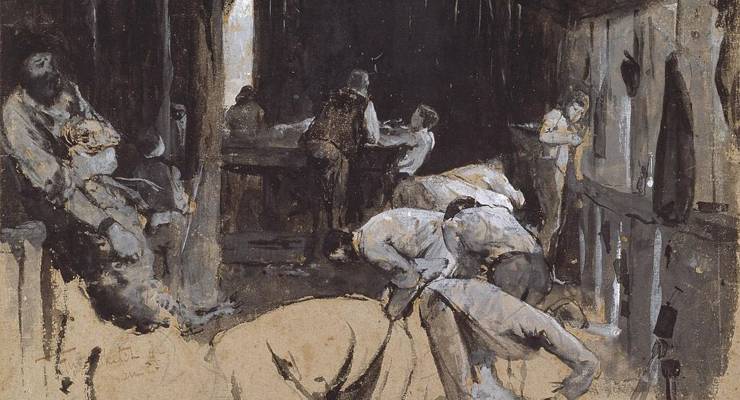
In 1876, a 17-year-old boy landed in Australia on a ship called the Lochiel. We don’t know his original name, but his naturalisation records nearly two decades later noted him as a “native of Corea” who worked as a shearer in Gol Gol, a tiny town in far-west New South Wales. He gave himself an English name: John Corea. He is the earliest Korean migrant to Australia I have found in my research, though there is no doubt that many more human migration stories between the two countries have not yet been fully discovered.
As John Corea’s story shows, the Korean-Australian relationship began much earlier than many realise. People-to-people relations are longer and deeper than state-to-state relations between South Korea and Australia, which only celebrated the 60th anniversary of their diplomatic relationship last year. In the coming years, human relations should be the real driver to strengthen ties between the two countries. The relationship will be increasingly important as both countries weather geopolitical turmoil in the Indo-Pacific.
Existing diplomatic ties between South Korea and Australia are largely weak and shallow. Their relationship is primarily built on the fact that both are US allies. As great-power competition between Washington and Beijing ramps up, bilateral relations have continued to remain secondary to Seoul and Canberra’s primary foreign-policy goals: remaining part of the US-led international liberal order while still benefitting from trade with China, their biggest trading partner.
The current bilateral relations, as framed in the two countries’ 2021 Comprehensive Strategic Partnership (CSP), thus centre on mutual security and trade interests in the context of US-China rivalry in the region. People-to-people links “underpin the CSP” but appear to take a backseat to strategic, security and economic interests, as well as innovation and technology.
Meanwhile, the only public narratives of human relations featured in bilateral relations have been Australian veterans in the Korean War and, more recently, early Australian missionaries in colonial Korea. These narratives often leave out, for instance, Korean labourers’ and skilled migrants’ contributions to Australia’s economy and society.
Yet, while there is still much we do not know about the early days of the Korean-Australian story, there have been waves of Korean migration, big and small, over the past 150 years. Some of the earliest Korean labour migrants in the Australian outback arrived in the late 19th century, long before Australian Federation, as in the case of John Corea. Many were shearers and miners in Victoria and New South Wales, as well as pearl divers in North Queensland and West Australia, who came along with other Asian migrants of the time such as the Chinese miners and Japanese pearl divers.
After the Korean War, Australian servicemen and missionaries brought home a small number of Korean wives and war orphans. Thousands of Korean labour migrants entered Australia during and after the Vietnam War, many of whom were granted amnesty when the White Australia Policy (the official policy that prohibited non-Europeans, especially Asians, from immigrating to Australia) ended in 1973. After the Cold War and South Korean travel liberalisation that allowed full freedom of overseas travels in 1991, a subsequent wave of Korean immigrants came to settle in Australia. The 2021 Australian Census estimates 105,560 Koreans living in Australia, the 15th-largest overseas-born population. There are also growing numbers of second-generation or mixed-heritage Korean Australians who were born in Australia, though we do not know the exact figures.
While the number of Australians currently residing in South Korea is small — 1632 people as of 2020 — there has long been migration in that direction as well. Since the first Australian missionary, J Henry Davies, arrived in Korea in 1889, the Presbyterian Church of Victoria and its Women’s Missionary Union have been sending missionary teachers, nurses and doctors to Korea, especially to its southeastern regions of Pusan and Masan. Australian missionaries also brought students and trainees to Australia for vocational training and helped build schools and hospitals in colonial Korea. In post-war Korea, Australian missionaries continued to be involved in South Korean labour movements in Seoul’s Yeongdeungpo District.
But the human dimension to Korea-Australia relations is more than just a matter of historiography. The promise of new job opportunities that brought John Corea to Australia’s shores in 1876 still holds true today. After the unprecedented border and travel disruptions of the COVID-19 pandemic, Australia is once again in need of workers. Almost everyone I met during my latest field trip in May mentioned labour shortages in the country. From a grocery owner in Sydney’s central business district to a hairdresser in the suburb of Strathfield (which has one of the largest Korean populations in the country), employers talked about how difficult it has been to hire staff, especially in the past two years. The more I drove west of Sydney, the more shortages were felt by local businesses, factories and farms. Strict border policies during the pandemic have had a real impact on these businesses, as well as science, technology and research.
Australia also suffers from a shortage of talent and skilled migration. During my fieldwork in outback Australia, migrant placement agencies in rural Australia said they are finding it difficult to recruit skilled workers in agriculture and manufacturing sectors. In cities, business owners, hospitals, construction and universities find it challenging to recruit qualified staff. For nearly two years, Australia’s borders were closed due to the pandemic, and even after that, Australia has failed to attract skilled migrants and international students from Asia. This may be due in part to pandemic-related racism against people of Asian heritage. Recently, the federal government announced that skilled migration will be a priority, but the scope of the plan is unclear.
South Korea, with a population more than twice the size of Australia’s, has the opposite problem. The youth unemployment rate has hovered at a high 7% to 11% over the past 10 years. In February, the unemployment rate for South Korean youth aged between 15 and 24 with tertiary education, who make up 70% of the population, was 10.2%, one of the lowest among Organisation for Economic Cooperation and Development members.
South Korea’s surplus of a skilled youth workforce can be a solution for Australia’s talent shortage. But in order to explore this possibility, both the South Korean and Australian governments need to consider how to make cross-border and cross-cultural experiences easier for skilled migrants and their families.
At a policy roundtable organised by the Korea-Australia Relations Project in May, some of these skilled migrants shared their views. The following recommendations are based on the discussions we had at the policy roundtable, which was funded by both the South Korean and Australian governments. If Seoul and Canberra take these steps, both governments — and migrants — stand to benefit.
First, visa processes in both countries should be more friendly and less costly. As visa categories constantly change to reflect domestic markets, migrants in both countries often find it difficult to keep up with latest developments. Visa processing time can take years and be expensive. The base cost of a Skilled Employer Sponsored Regional visa is $4240 per migrant, while bringing a partner costs an additional $8085.
To address these issues, Canberra’s skilled migration program could respond by balancing the domestic needs of workforce with incoming migrants in both labour-intensive and skilled sectors. Seoul, meanwhile, could look into more effective ways of accommodating skilled migrants and more reasonably targeting income thresholds (which stand at three to four times higher than the South Korean national average). Currently, if a migrant does not have a Korean partner, it is extremely difficult to obtain or renew a skilled visa in South Korea.
Second, both governments should consider skilled migrants along with their families as building blocks for their future economies and societies, and thus create more family-friendly border control. Building cross-cultural families and diverse yet inclusive communities is the heart of successful immigration policy. The latest pandemic border restrictions have separated many families between Australia and South Korea. Highly skilled migrants now look for longer-term residency with better global mobility for their families. If Australia and South Korea want to retain foreign talents in their countries, they need to implement family-friendly immigration policies.
Third, both Australian and South Korean governments and society should promote more inclusive values and respect for diversity. Racism is a problem in both societies. In Australia, the legacies of colonialism and the White Australia Policy endure. In South Korea, which lacks an anti-discrimination law, xenophobia is widespread. According to the 2021 Korean Australian Survey, most Korean Australians have experienced discrimination. Meanwhile, many long-term resident Australians in South Korea feel they are treated as permanent outsiders. It will take time for each society to overcome these ills, but both governments should make it a priority.
If South Korea and Australia return to the roots of their relationship, they will find a more enduring basis for the future than just trade or security or US interests. It is time for both countries to pay more attention to — and adjust their policies for — each other’s people, and thus celebrate the unsung heroes at the centre of their relations: the migrants who have contributed greatly to each other’s economy and society.









Thoughtful and positive article, thanks.
Very insightful and positive article with a number of good policy ideas
Good article from a potential source of submarines. Never met anyone who doesn’t like Koreans. We should be more friendly with our neighbours than with those on the other side of the world. Stands to reason. The dark side of the planet treats us like mugs. Were the Poms with us in Nam? No. Were the Koreans? Sure were. And we previously helped them mow down the massed charges of the northern horde, and we would do it again, for freedom. Just saying.
Were the Yanks with us during Sukarno’s confrontation in Borneo, West Irian or Este Timor?
Well the US was not formally ‘with us’ in East Timor, but the US cruiser group that sat in the Brisbane river taking up a lot of shoreline at that time was very suggestive of what could have joined in if things got out of hand.